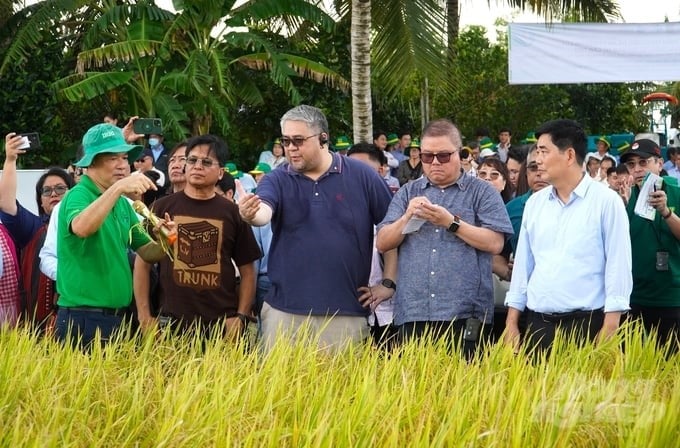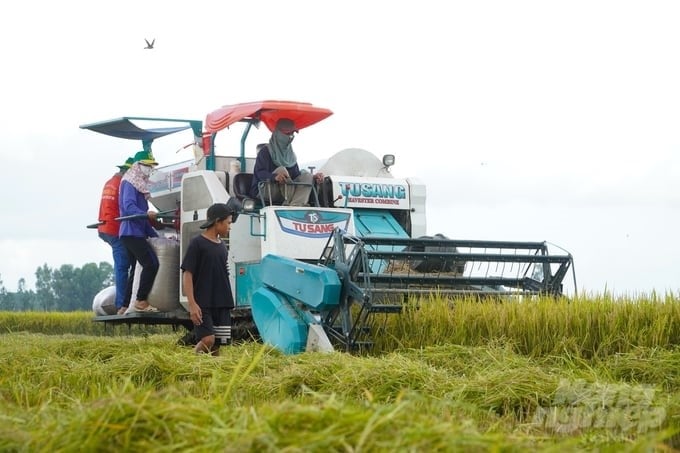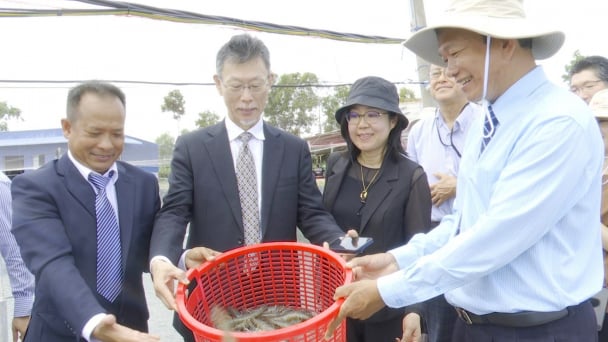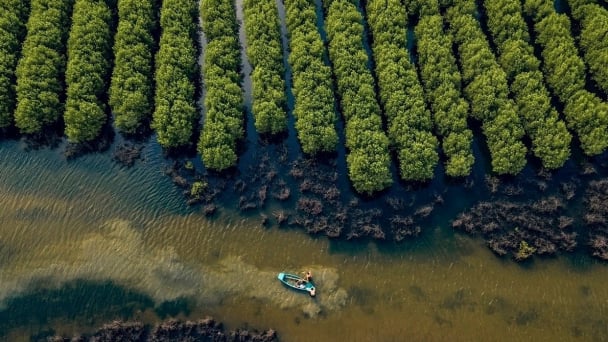June 16, 2025 | 05:21 GMT +7
June 16, 2025 | 05:21 GMT +7
Hotline: 0913.378.918
June 16, 2025 | 05:21 GMT +7
Hotline: 0913.378.918

The Philippines Minister of Agriculture, Mr. Francisco P. Tiu Laurel, Jr. (2nd from right), visited the emission-reducing field in Can Tho. Photo: Kim Anh.
On July 8, the Department of Agriculture and Rural Development of Can Tho City, in collaboration with the Department of Crop Production (Ministry of Agriculture and Rural Development) and the International Rice Research Institute (IRRI), organized a meeting to review the first pilot model of the 1 million hectares of high-quality, low-emission rice project.
The model is deployed in the summer-autumn crop of 2024 at Tien Thuan Agricultural and Service Cooperative (renamed Thuan Tien Agricultural Cooperative) in H2 hamlet, Thanh An commune, Vinh Thanh district, Can Tho City.
The field uses certified variety OM5451, row sowing by machine combined with fertilizer burying, alternate wetting and drying (AWD) water management, site-specific nutrient management (SSNM), and integrated pest management (IPM). During the harvesting process, the model applies a combine harvester, collecting straw from the field to make straw mushrooms and organic fertilizer.
After 3 months of growing, Can Tho ity's first emission-reducing field was harvested with many positive results.

Visitors evaluate the quality of rice grains at the emission-reducing field in Can Tho. Photo: Kim Anh.
Regarding the amount of rice seeds sown, it decreased from 140 kg/ha to 60 kg/ha. The number of fertilization times was reduced from 3–4 times/crop to 2 times/crop. Thereby reducing at least 20% of chemical fertilizers.
In addition, the synchronous application of farming techniques according to the process of the 1 million hectares of high-quality rice project issued by the Ministry of Agriculture and Rural Development has also helped Tien Thuan Cooperative save significantly on irrigation water, decrease disease risks, limit rice plants from falling over, and reduce post-harvest losses.
Regarding economic efficiency, Dr. Nguyen Van Hung, a senior expert at IRRI, analyzed that reducing seeds and fertilizers has helped farmers save costs of about VND 1.9 million/ha, increasing fertilizer use efficiency.
The Thanh An commune land's characteristic is that it is slightly contaminated with alum, so the average rice yield in the summer-autumn crop only reaches about 5.9 tons/ha (traditional sowing). However, in the farming model following the emission reduction process, rice yield increased to 6.13–6.51 tons/ha.

Farming according to the process set out in the 1 million hectares of high-quality rice project helped rice yield in the model increase to 6.13–6.51 tons/ha. Photo: Kim Anh.
After balancing revenue from rice plants and straw and reducing costs of field preparation, water pumping, pesticides, seed treatment, fertilizer, and sowing, Mr. Hung gave an increase in the net profit of the pilot model at Tien Thuan Cooperative of VND 1.3–6.2 million/ha.
Although this result has only been evaluated through one farming crop, Mr. Hung believes that these are reliable numbers because the model was deployed in three consecutive crops and implemented on a large scale with mass production and the support of relevant technologies.
In particular, the model has helped reduce greenhouse gas emissions into the environment by about 2–6 tons of CO2 equivalent/ha, thanks to water level sensors installed in the field to collect parameters accurately and transparently.
Can Tho City's first emission-reducing field has the participation of three businesses. Tu Sang Agricultural Machinery Company provides sowing combined with fertilizer-burying technology. Binh Dien Fertilizer Joint Stock Company provides a package of technical solutions using new technology fertilizers that prevent losses and increase fertilizer use efficiency. Hoang Minh Nhat Joint Stock Company links to purchase all products from farmers in the model.
Mr. Le Thanh Tung, Deputy Director of the Department of Crop Production, assessed that the close participation between businesses providing input agricultural materials and businesses consuming output rice will help the linkage chain become practical and responsible and demonstrate the true commitments of the parties.
This is an important factor in helping the emission-reducing field achieve success and gradually spread throughout Can Tho City and four other localities that are piloting the project.

Signing ceremony of the economic contract to buy and sell fresh rice for three consecutive crops between Hoang Minh Nhat Joint Stock Company and Tien Thuan Cooperative. Photo: Kim Anh.
Mr. Phan Van Tam, Deputy General Director of Binh Dien Fertilizer Joint Stock Company, also said that the strong participation of "strong enough and large enough" businesses will contribute to helping the 1 million hectares of high-quality rice project to be implemented faster and more sustainably.
To replicate the model according to the agricultural sector's expectations, according to Mr. Tam, there is still much work to be done. Especially promoting communication work, providing accurate information that must be synchronized on social platforms so that farmers trust, respond, and agree to participate in the project.
On this occasion, Hoang Minh Nhat Joint Stock Company and Tien Thuan Cooperative signed an economic contract to buy and sell fresh rice for three consecutive crops: summer-autumn of 2024, autumn-winter of 2024, and winter-spring of 2024-2025.
The Department of Crop Production awarded the Certificate of Production Area applying the technical process of high-quality and low-emission rice production in the Mekong Delta to Tien Thuan Cooperative according to Decision No. 322 dated July 5, 2024, of the Director of the Department of Crop Production.
Translated by Thu Huyen
![Turning wind and rain into action: [4] Bringing climate bulletins to remote and isolated areas](https://t.ex-cdn.com/nongnghiepmoitruong.vn/608w/files/linhnhp/2025/06/14/1152-z6704423696987_15fd32ffc26d590d204d520c9dac6786-nongnghiep-151141.jpg)
(VAN) The Vietnam Agriculture and Nature Newspaper interviewed Mr. Vu Thai Truong, Acting Head of Climate Change and Environment at UNDP Vietnam, to gain deeper insight into how climate bulletins are delivered to farmers.

(VAN) In Tien Giang, a high-tech shrimp farm has developed a distinctive energy-saving farming model that has yielded promising results.
![Turning wind and rain into action: [3] 300.000 farmers benefit from agro-climatic bulletins](https://t.ex-cdn.com/nongnghiepmoitruong.vn/608w/files/news/2025/06/12/e5a48259d6a262fc3bb3-nongnghiep-125122.jpg)
(VAN) The agro-climatic bulletin has become a valuable tool for farmers in the Mekong Delta. After more than five years of implementation, the initiative is gradually being expanded nationwide.
![Turning wind and rain into action: [2] Providing forecasts to the people](https://t.ex-cdn.com/nongnghiepmoitruong.vn/608w/files/news/2025/06/12/e5a48259d6a262fc3bb3-nongnghiep-103927.jpg)
(VAN) In addition to improving the quality of hydrometeorological forecasts, putting forecast bulletins into practical use is crucial for production and disaster prevention.

(VAN) Blue carbon is receiving attention for its rapid absorption capacity and vast potential. It represents a promising nature-based solution to respond to climate change.
/2025/06/11/3507-1-161904_583.jpg)
(VAN) Seagrass beds and coral reefs serve as 'cradles' that nurture life in the ocean depths, creating rich aquatic resources in Vietnamese waters.
![Turning wind and rain into action: [1] Forecasting for farmers](https://t.ex-cdn.com/nongnghiepmoitruong.vn/608w/files/news/2025/06/11/e5a48259d6a262fc3bb3-nongnghiep-111919.jpg)
(VAN) Weather is no longer just a matter of fate. Forecasts have now become an essential companion for farmers in every crop season.